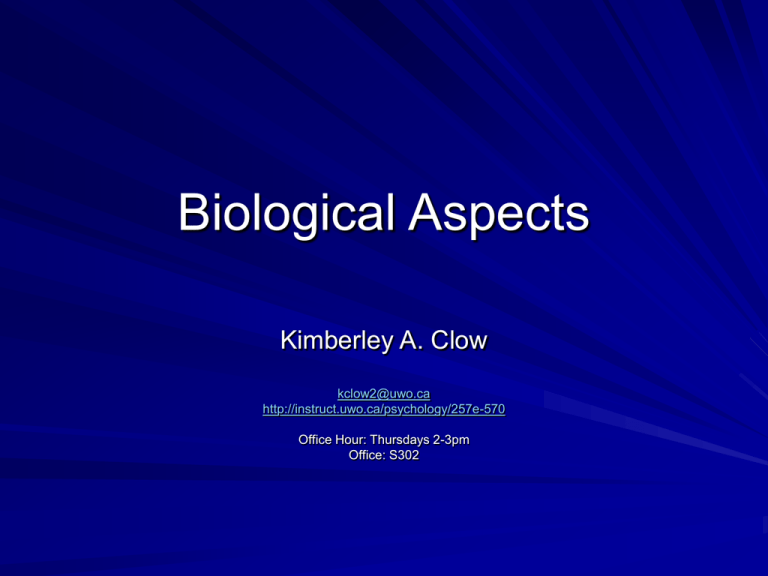
Biological Aspects
Kimberley A. Clow
kclow2@uwo.ca
http://instruct.uwo.ca/psychology/257e-570
Office Hour: Thursdays 2-3pm
Office: S302
Outline
Welcome to the Brain
The Nervous Systems
– Neural Communication
Extraversion
– Return to Eysenck’s Arousal Theory
– Gray’s Interpretation
Sociobiology
– Prosocial Behaviour & Learning
– Mate Selection
The Cortex
Hemisphere Lateralization
Gender Differences?
Messages from Brain Travel by
Nervous System
Spinal
Cord
Brain
Nerves
The Central Nervous
System is the
Communications
Highway of the body
Somatic Nervous System
Sensory Neurons
– input from body to Central
Nervous System
Motor Neurons
– output from Central
Nervous System to
control muscle
movements
Interneurons
– sensory-motor relay within
Central Nervous System
Autonomic Nervous System
Neurons are the Messengers
Neurons
– Information
Processing Cells
– 100 billion
neurons in the
brain!
Neural Communication
Types of Neurotransmitters
Neurotransmitter
Source and Function
Acetylcholine (ACH)
Controls muscles; attention and memory
Alzheimer’s Disease
Dopamine
Controls muscles; can cause hallucinations
Schizophrenia
Endorphins
Suppresses pain
Gamma aminobutyric
acid (GABA)
Works against neurotransmitters, especially dopamine
Norepinephrine
Regulates mood; increases arousal and alertness
Mood Disorders, Eating Disorders
Serotonin
Opposition to norepinephrine, suppresses activity,
causes sleep
Anxiety Disorders, Mood Disorders, Eating Disorders
Brain Still in Control!
Altering of
neurotransmitters
based on messages
from brain
Absence or
overabundance can
create whole new set
of consequences
Biology on Personality
How do you show that personality has a
biological basis?
– Relate behaviours to brain structures
– Heritability or genetic contributions
Twin Studies
– Observations in human & nonhuman animals
– Evidence in many different cultures
Cultural Universals
– Stability over time
Remember Eysenck?
3 Factors of Personality
– Extraversion
– Neuroticism
– Psychoticism
Eysenck’s Model
Extraversion - Introversion
Optimal Arousal Levels
Gray
Model of Responsiveness
Dopamine & Extraversion?
Encephalitis Lethargica
ADHD
Sociobiology
Born from Darwin’s Theory of Evolution
– Survival of the Fittest
Too many people; Too few resources
– Natural Selection
Favours behaviours that maximize survival and
reproductive success
– The survival of your genes
Inclusive Fitness
– Your siblings and relations have your genes
too!
Prosocial Behaviour
Nepotism in Action
80
60
% Helping
40
20
0
High
Medium
Low
Degree of Relation
None
Learning
Prepared Learning
– Some things are
easier to learn than
others
Language
– We learn some
associations but not
others
Animal Specific
What’s Love Got to Do With It?
Argument that “love” is just an adaptation to
insure survival of the species
– It keeps parents together to provide protection of
offspring who require a lengthy period of
development before they can fend for
themselves
– Evident in gender differences
Mate selection
Sexual Relations
Desirable Qualities in Mate
Views on Infidelity
Human Reproductive Strategies
Male Strategy
– Inseminate as many females as possible
– Promiscuous sexual behaviour
– Devote only minimal resources to child care
Female Strategy
– Choose mate very carefully
– Monogamous sexual behaviour
– Remain attached to mate for resources
When to Have Sex
Number of Partners
Chastity
Success
Physical Attractiveness
Age
Fidelity
What would bother you
more?
– Sexual Infidelity
– Emotional Infidelity








